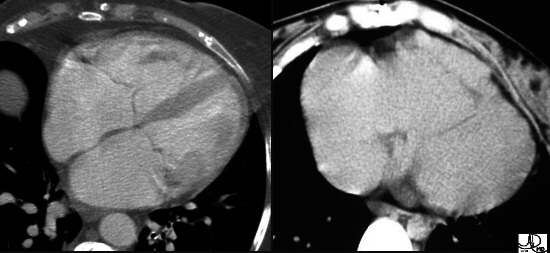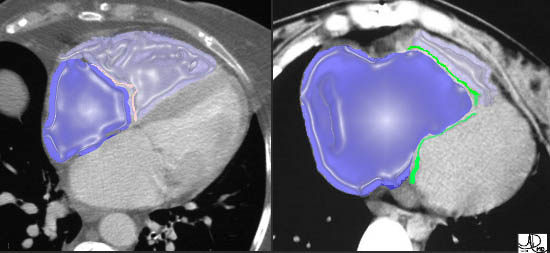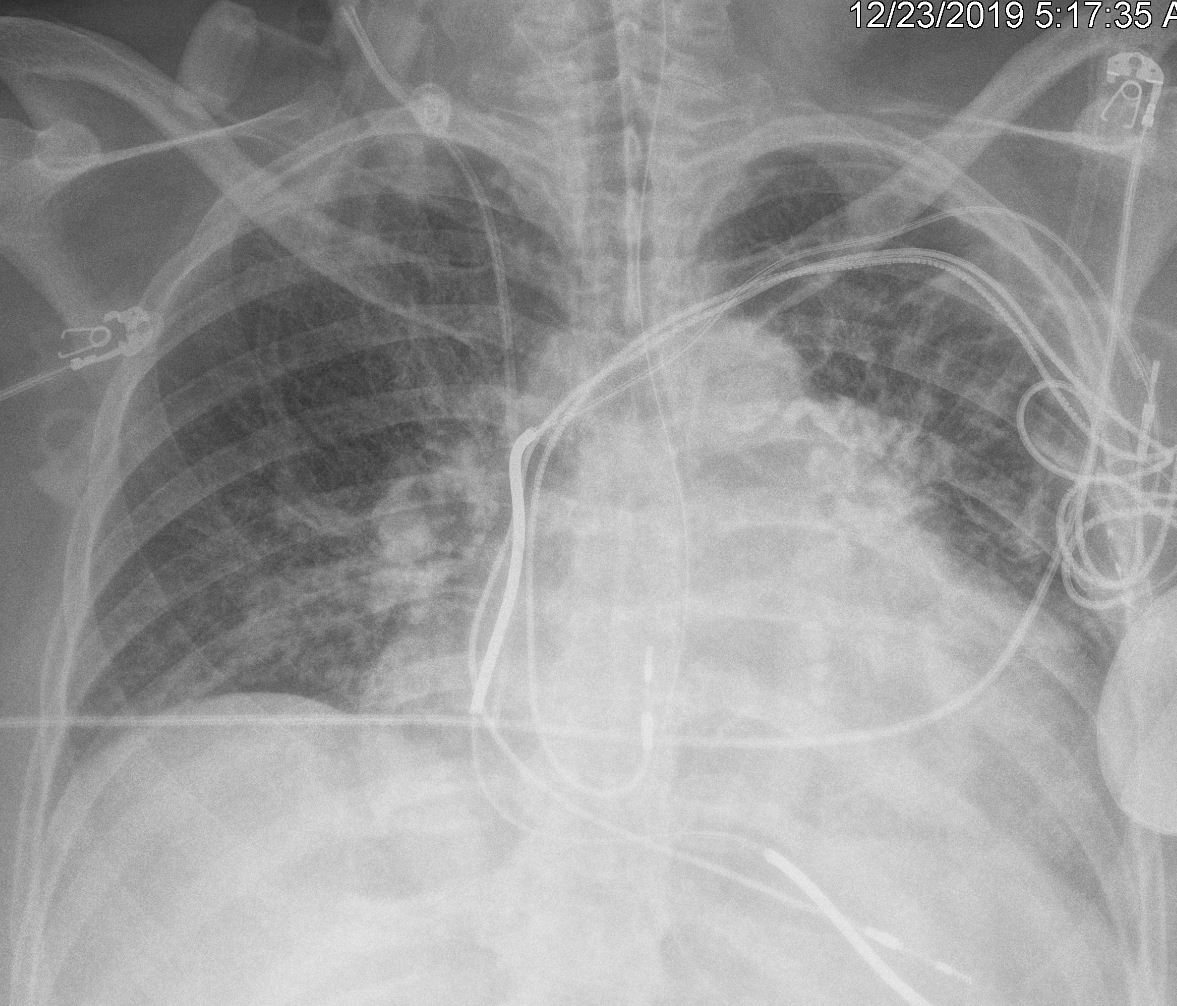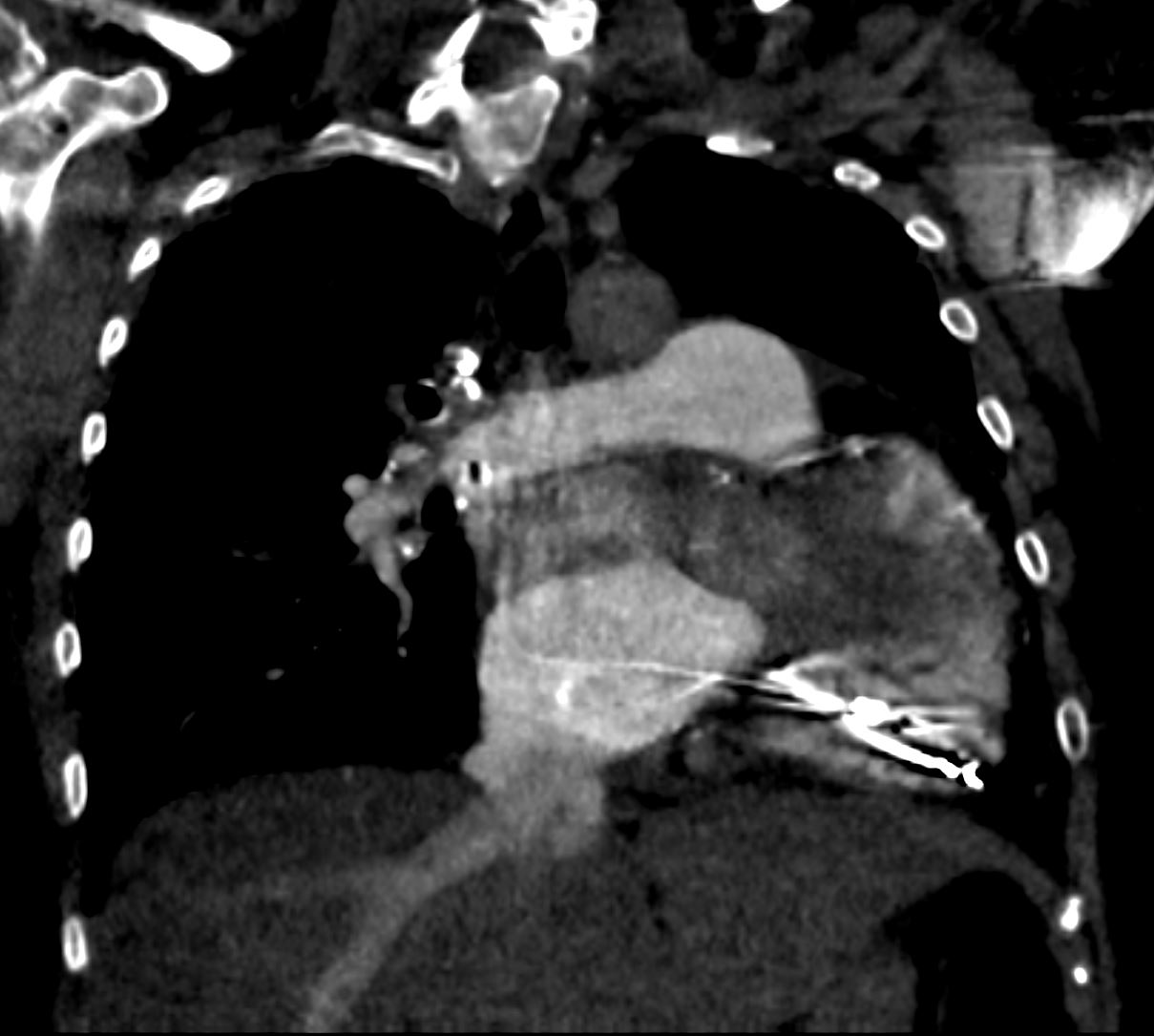Introduction
The linear measurements for the normal right atrium are a short axis of 3.5 cms and a long axis of 5.5cms. Since it has the same volume as the left atrium it should be about the same size but comparison is not that easy for a few reasons, including the different orientations of the chambers as well as the fact that they often lie in different planes making comparison at a single level difficult.. The long axis of the right atrium is mostly in an A-P direction,whereas the long axis of the left atrium is mostly in a transverse direction. They also lie only a slightly different axial plane so theat theright strium (like most right sided structures
On CXR
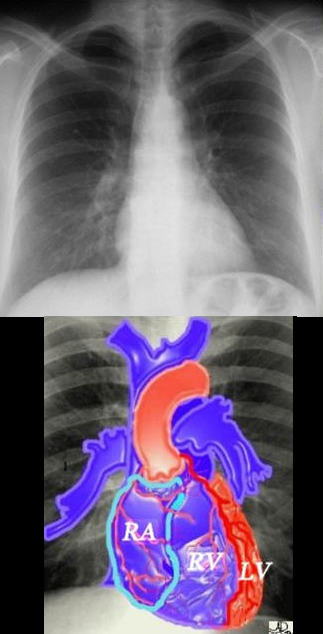
The right atrium (RA) forms the heart border with the right lung. The RA is posterior to the RV so it does not form an anterior border of the heart.
Ashley Davidoff MD
On Lateral Examination
On the lateral examination the right atrium is not border forming and so it is not visible.
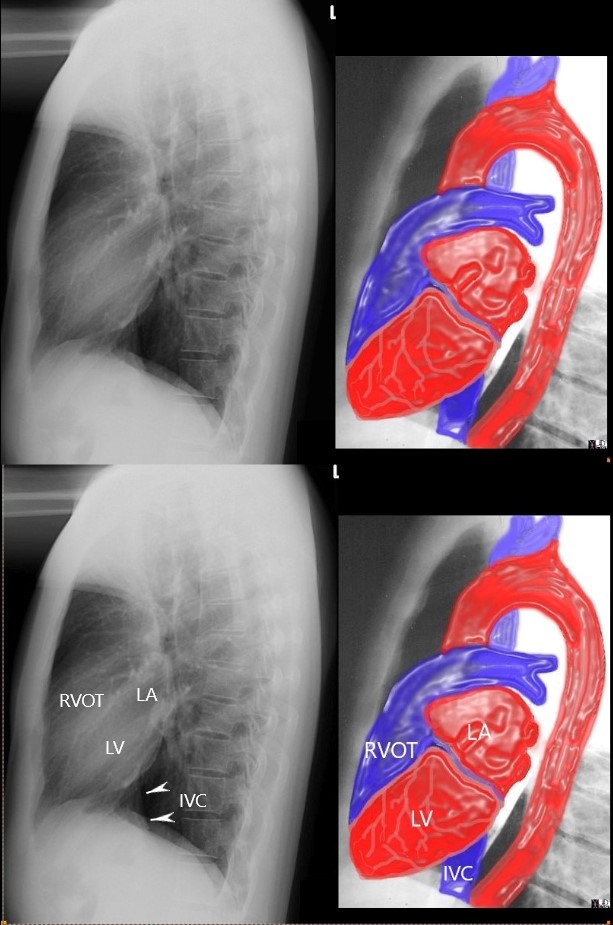
Ashley Davidoff MD

THE RIGHT ATRIUM – INVISIBLE ON THE LATERAL EXAMINATION The right ventricle is anterior to the left and is also superior. The right atrium (blue ring overlay) is slightly superior and anterior to the LA i.e. blue right sided structures are superior and more anterior than red left sided structures . The atria are superior and posterior to the ventricles as shown in the diagram.
Ashley Davidoff MD
Normally, right and left atria are the same size.

Normal Right Atrium and Left Atrium |
| This axial image of the heart is through the mitral (right ) and tricuspid valve (left) right atrium and left atrium (right) which are normal and about the same size. The left ventricle with the papillary muscles and the right ventricle with its papillary muscle are well seen. Note the right sided structures tend to be anterior and left sided structures tend to be posterior. Note also that the right atrium and the left atrium are about the same size and shape in this view with flat walls. The right atrium is anterior to the left atrium and posterior to the RV. It is close to the anterior border but does not quite make it.
Courtesy Ashley Davidoff MD copyright 2009 all rights reserved 27531d01.8s |
The Enlarged Right Atrium
- enlarged, globular heart
- narrow pedicle
- gross enlargement of the right atrial shadow, i.e. increased convexity in the lower half of the right cardiac border
- right atrial convexity is more than 50% of the cardiovascular height
- right atrial margin is more than 5.5 cm from the midline
RAE on the FRONTAL x-RAY
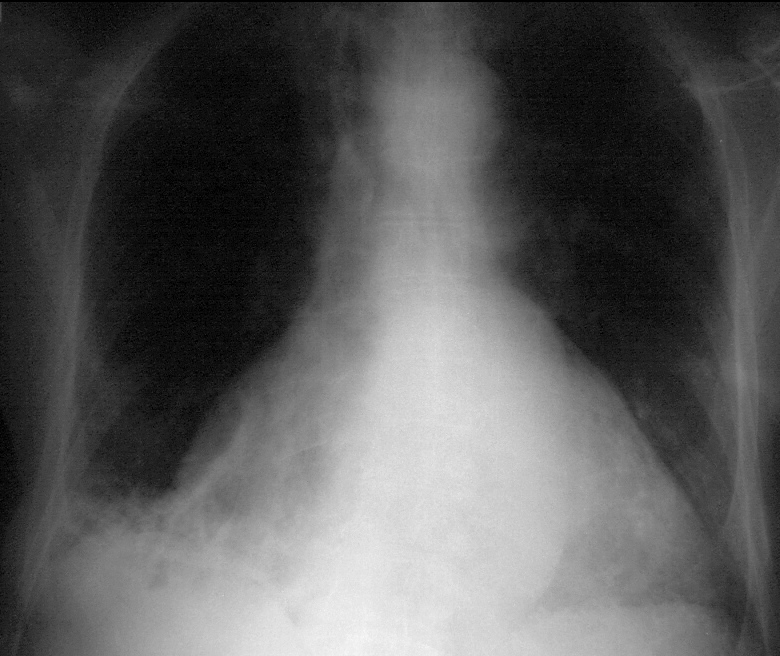
83-year-old male with significantly enlarged right atrium, as well as a mildly enlarged left atrium with evidence of CAD, atrial fibrillation and hypertension.
On frontal CXR the findings are consistent with a large right atrium characterized by the globular shape of the heart, large right heart border occupying more than 50% of the cardiovascular height.
Ashley Davidoff MD

83 year old male with significantly enlarged right atrium, as well as a mildly enlarged left atrium with evidence of CAD, atrial fibrillation and hypertension.
On the lateral CXR , the right atrium is positioned against the anterior chest wall. In addition the right atrial appendage is so large that it lies against the sternum. The RA therefore occupies the entire retrosternal air space and results in decrease of the retrosternal airspace. This is the rare instance when the RA shares with, but dominates the anterior retrosternal position with the RV.
Ashley Davidoff MD
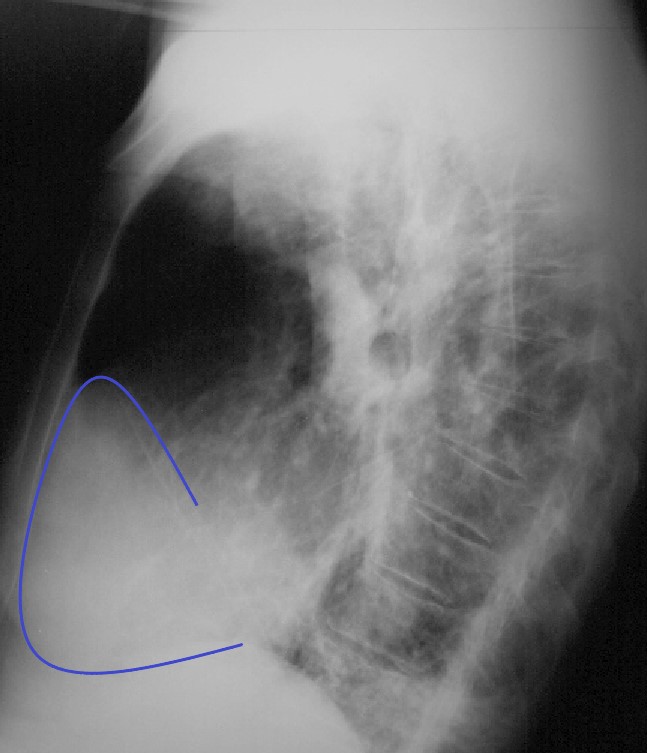
83-year-old male with significantly enlarged right atrium, as well as a mildly enlarged left atrium with evidence of CAD, atrial fibrillation and hypertension.
On the lateral CXR, the right atrium the blue line overlay indicates the position of the RV against the anterior chest wall. In addition, the right atrial appendage is so large (see CT below) that it lies against the sternum. The RA therefore occupies the entire retrosternal air space and results in decrease of the retrosternal airspace. This is the rare instance when the RA shares with, but dominates the anterior retrosternal position with the RV.
Ashley Davidoff MD
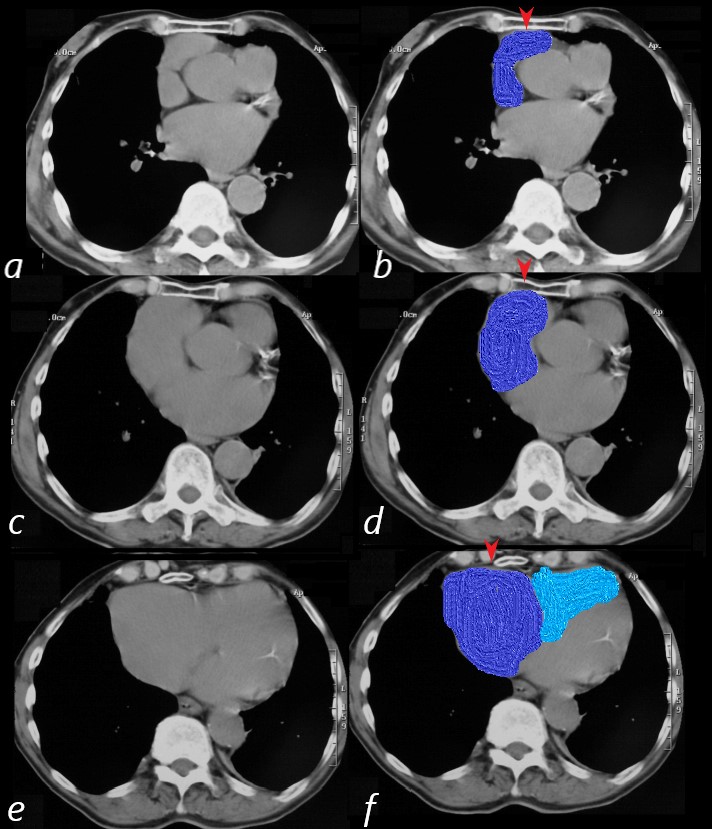
83-year-old male with significantly enlarged right atrium, as well as a mildly enlarged left atrium with evidence of CAD, atrial fibrillation and hypertension.
On CT scan the right atrium and appendage (blue overlay (b,d,f) are positioned against the anterior chest wall and sternum (red arrowheads). On the superior most images (b,d) the RV is not present and only takes up a retro-sternal position alongside the right atrium on the most inferior image (f)
Ashley Davidoff MD
|
Right Atrium Normal and Enlarged |
| These two images are enhanced CT images through the tricuspid valve. The first image is normal, while the second image demonstrates a TV that lies too far forward and low associated with a huge RA and a diminutive RV. This appearance is classical of a congenital condition called Ebstein’s anomaly. In this disease, the posterior leaflet is stuck down to the posterior wall of the RV and the anterior leaflet is larger than normal often giving a flapping sound to the listening ear. The anterior leaflet behaves like a flapping sail in the wind of the blood flow.
In the overlays, the RA is in royal blue and the RV is in light purple overlay. The normal TV in the first image is in pink while the malformed valve in the second image is in green. Note how large the RA is and how small the RV is in Ebstein’s anomaly. Courtesy of Ashley Davidoff M.D. 32102 32101 copyright 2009 |
On the CXR
Shape of the Cardiomegaly
What about the Right Atrium (RA) and Right Heart Border?
The RA does not make much a statement on the frontal CXR

If we were to “crack open” the chest of the chest X-ray, the structures that would dominate this bloody, black and white scene, would be the right sided chambers. The right ventricle (RV) would be the dominant anterior chamber, and would form the dominant interface with the diaphragm. The right atrium (RA) would form the border with the right lung. The RA would of course be slightly posterior to the RV. The left border would be formed by the left ventricle. Most the left ventricle is hidden posteriorly in this view. The left anterior descending artery would be visible from this anterior view. It marks the position of the interventricular septum.
Ashley Davidoff MD
The right atrium is the most difficult chamber to assess unless it is very large in which case it will present on the frontal CXR with a very large right paravertebral border.
When it is mildly or even moderately enlarged it is difficult to identify on plain films .
As is so often the case shape changes assist greatly in evaluating size of the heart
- enlarged, globular heart
- narrow vascular pedicle
- gross enlargement of the right atrial shadow, i.e. increased convexity in the lower half of the right cardiac border
- right atrial convexity is more than 50% of the cardiovascular height
- right atrial margin is more than 5.5 cm from the midline
- reference structures
- thoracic vertebral bodies
- height of a thoracic vertebral body typically ranges from approximately 25 to 30 millimeters (mm)
- the transverse diameter of an adult thoracic vertebral body typically ranges from approximately 30 to 45
- thoracic vertebral bodies
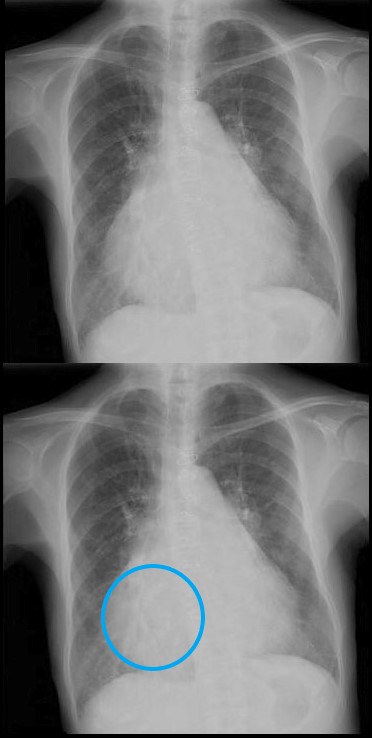
The right atrium is the most difficult chamber to assess unless it is very large in which case it will present on the frontal CXR with a very large right paravertebral border. This is a 71 year old female person with rheumatic heart disease with pulmonary hypertension and tricuspid regurgitation hence resulting in a large right atrium (RAE)
Ashley Davidoff MD

The right atrium is the most difficult chamber to assess unless it is very large in which case it will present on the frontal CXR with a very large right paravertebral border. The frontal CXR and coronal CT through the RA is from a 71 year old female with rheumatic heart disease with pulmonary hypertension and tricuspid regurgitation resulting in a giant right atrium (RAE). The RA accounts for the large bulge of the right border of the cardiac silhouette. The black arrowhead in the loer image points to the calcified mitral valve.
Ashley Davidoff MD
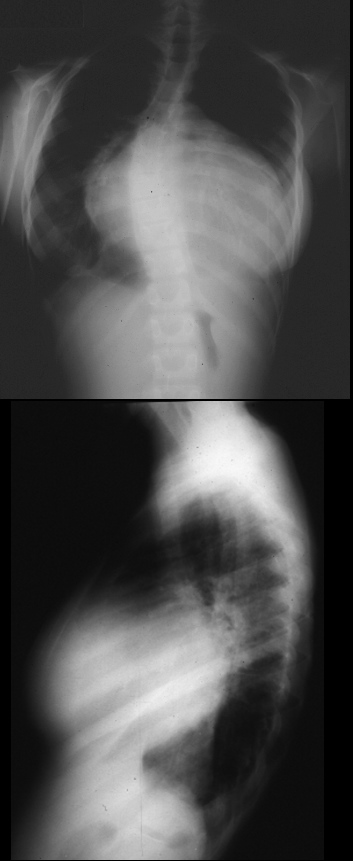
35 year old patient with severe mitral stenosis . with left atrial enlargement (LAE) characterized by elevation of the left mainstem bronchus, straightening of the left heart border, and prominence of the upper 1/3 of the posterior border of the heart. The right atrium is also enlarged characterized by a rotund right heart border. There is right ventricular enlargement characterized by filling in of the retrosternal airspace.
Ashley Davidoff MD
CT AND MRI
The linear measurements for the normal right atrium are a short axis of 3.5 cms and a long axis of 5.5cms. Since it has the same volume as the left atrium it should be about the same size but comparison is not that easy for a few reasons, including the different orientations of the chambers as well as the fact that they often lie in different planes making comparison at a single level difficult.. The long axis of the right atrium is mostly in an A-P direction,whereas the long axis of the left atrium is mostly in a transverse direction. They also lie only a slightly different axial plane so theat theright strium (like most right sided structures
Normally, right and left atria are the same size.

Normal Right Atrium and Left Atrium |
| This axial image of the heart is through the mitral (right ) and tricuspid valve (left) right atrium and left atrium (right) which are normal and about the same size. The left ventricle with the papillary muscles and the right ventricle with its papillary muscle are well seen. Note the right sided structures tend to be anterior and left sided structures tend to be posterior. Note also that the right atrium and the left atrium are about the same size and shape in this view with flat walls.
Courtesy Ashley Davidoff MD copyright 2009 all rights reserved 27531d01.8s |
|
Right Atrium Normal and Enlarged |
| These two images are enhanced CT images through the tricuspid valve. The first image is normal, while the second image demonstrates a TV that lies too far forward and low associated with a huge RA and a diminutive RV. This appearance is classical of a congenital condition called Ebstein’s anomaly. In this disease, the posterior leaflet is stuck down to the posterior wall of the RV and the anterior leaflet is larger than normal often giving a flapping sound to the listening ear. The anterior leaflet behaves like a flapping sail in the wind of the blood flow.
In the overlays, the RA is in royal blue and the RV is in light purple overlay. The normal TV in the first image is in pink while the malformed valve in the second image is in green. Note how large the RA is and how small the RV is in Ebstein’s anomaly. Courtesy of Ashley Davidoff M.D. 32102 32101 copyright 2009 |
Suggested measurements on echocardiography
-
- long axis: 3.4-5.3 cm
- short axis: 2.6-4.4 cm
- area: 10-18 cm2
- echocardiography estimates tend to be larger than on CT or MRI
MRI
- right atrial normal size (measured at end systole on four chamber view)
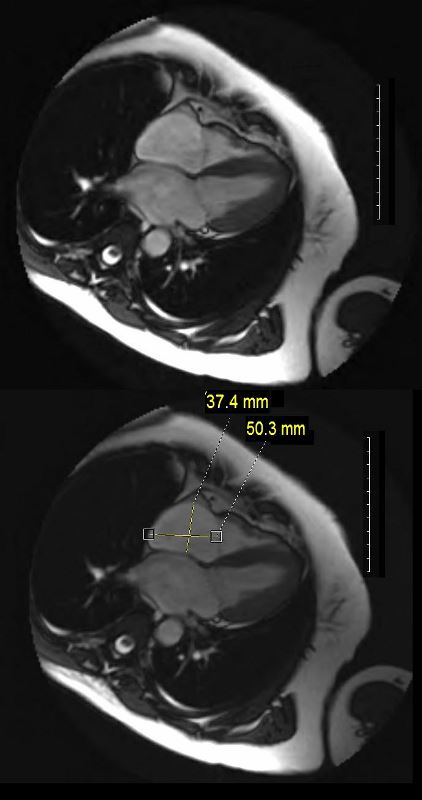
RIGHT ATRIUM – Normal
MRI of the normal heart using a 4 chamber view of shows normal size of the right atrium in 2 dimensions.
Ashley Davidoff MD
130625.8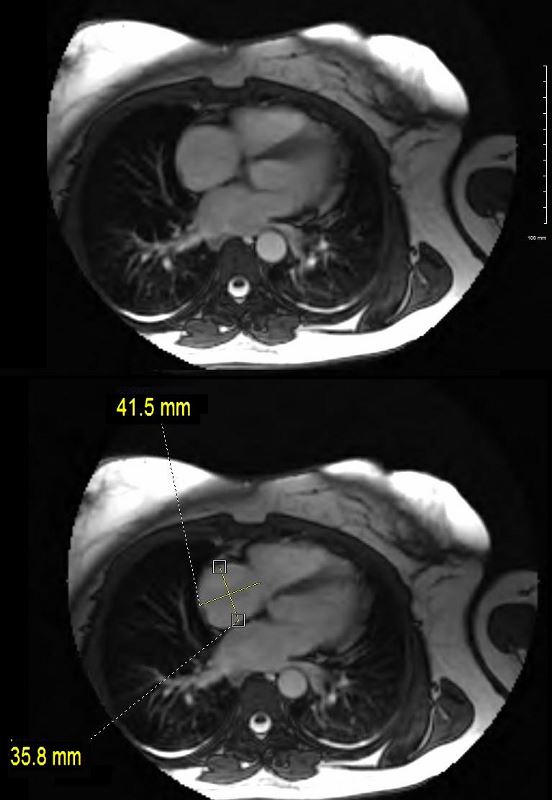
RIGHT ATRIUM – Normal
MRI of the normal heart using an axial projection shows normal size of the right atrium in 2 dimensions.
Ashley Davidoff MD
130626Small Right Atrium
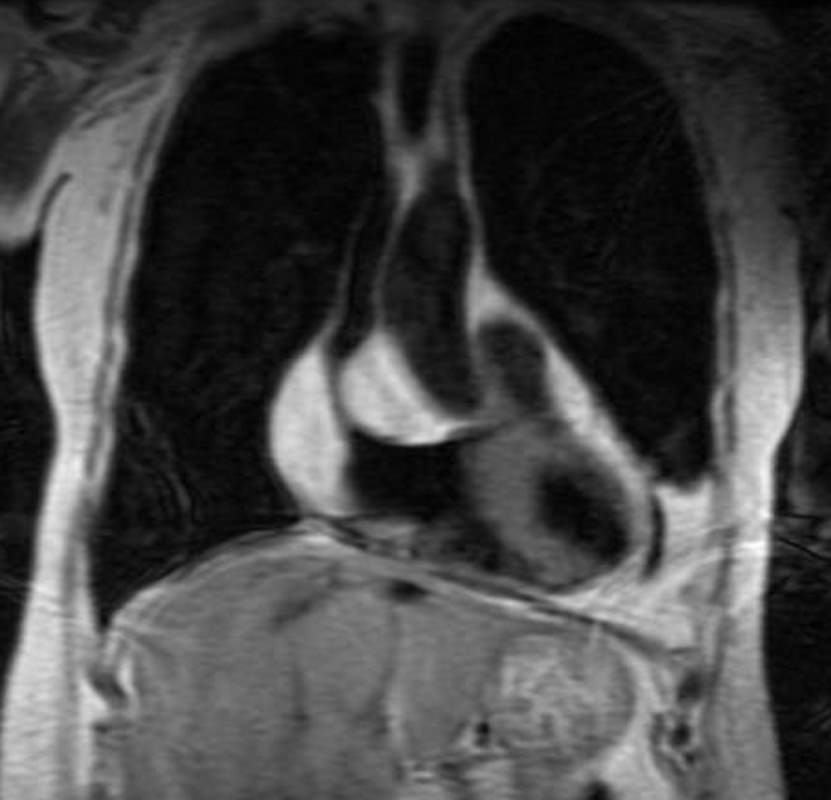
LIPOMA OF THE SVC AND RA
This image of a coronally acquired T1 weighted MRI image of the heart shows a high intensity mass surrounding the SVC and the entrance right atrium (RA) with narrowing of the SVC. There were no symptoms of SVC syndrome in this patient with known COPD. Note that the mass has the intensity of subcutaneous fat. An atrial lipoma is the most likely diagnosis.
Courtesy Jorge Medina
38449c
KEY WORDS
Cardiac, heart, vein, SVC , RA, mass, fat, lipoma, tumor, neoplasm, benign, imaging, radiology, MRI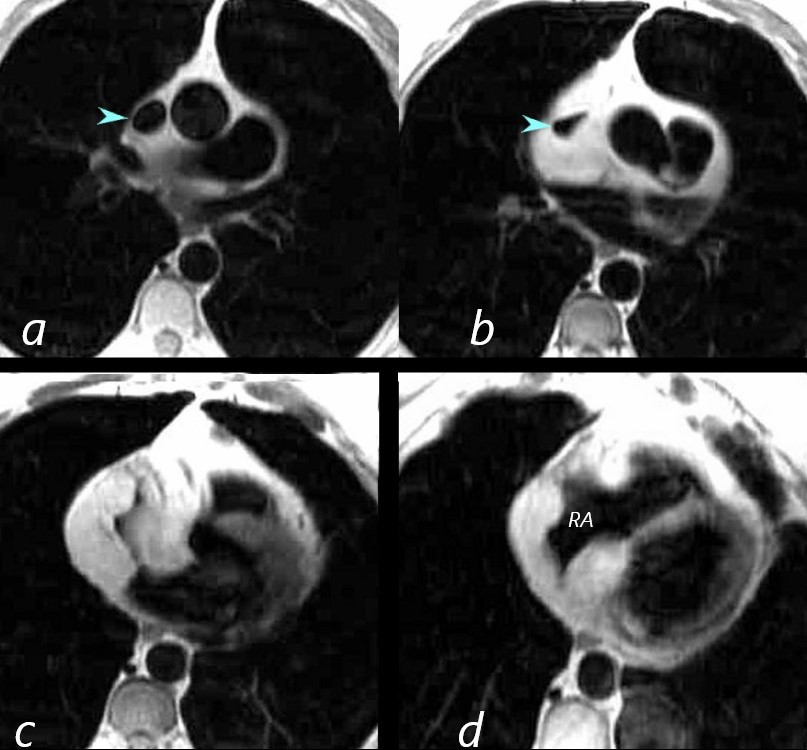
LIPOMA OF THE SVC AND RA
This series of axial T1 weighted MRI images of the heart show a high intensity mass surrounding the SVC (blue arrowhead) and the entrance to the right atrium (RA). There were no symptoms of SVC syndrome in this patient with known COPD. Note that the mass has the intensity of subcutaneous fat. An atrial lipoma is the most likely diagnosis.
Courtesy Jorge Medina
38449c
KEY WORDS
Cardiac, heart, vein, SVC , RA, mass, fat, lipoma, tumor, neoplasm, benign, imaging, radiology, MRICXR Emphysema and
Small Heart and Compressed Right Atrium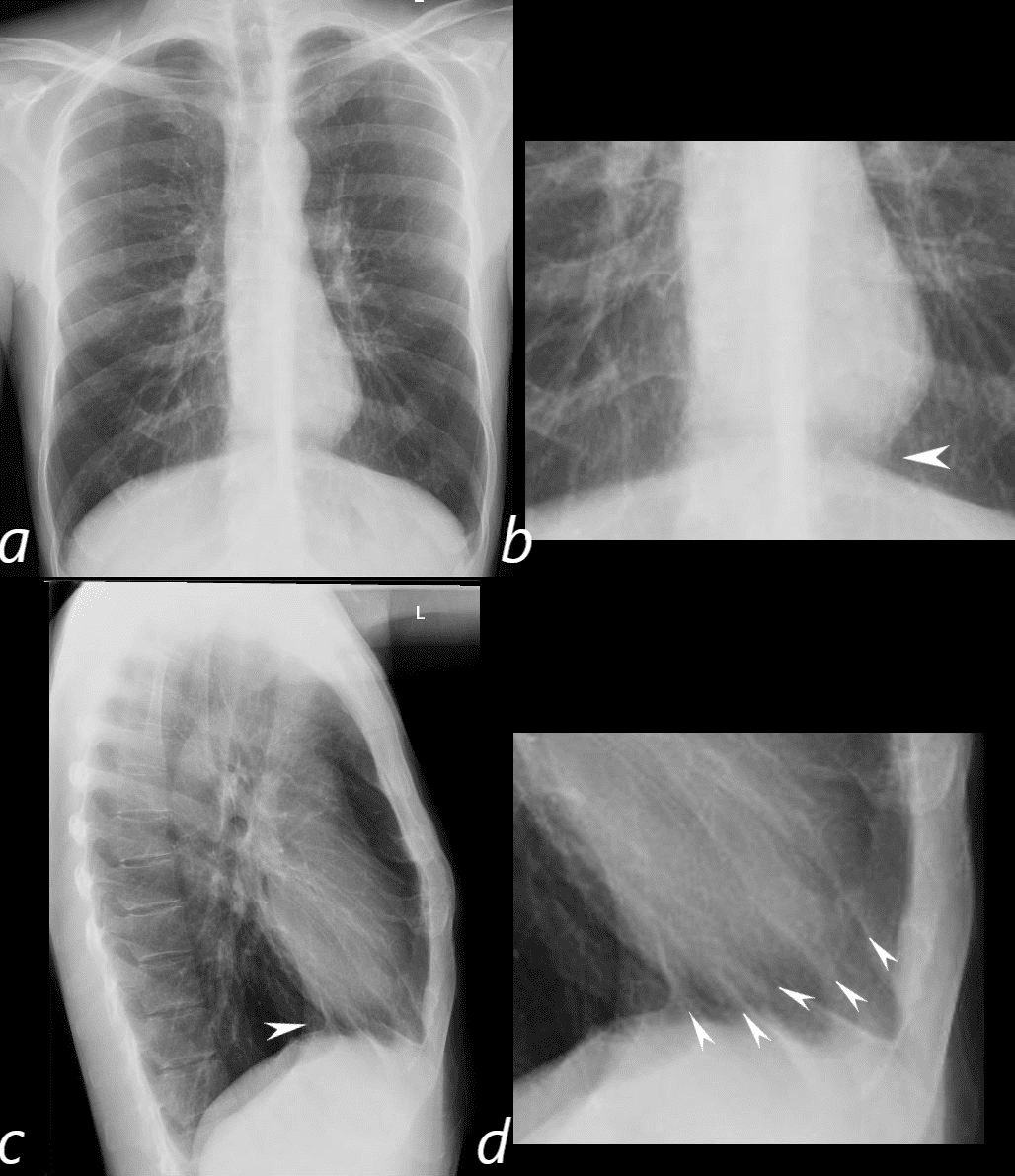
CXR Emphysema and Small Heart
58-year-old male presents with dyspnea. The lungs are hyperinflated with flattening of the diaphragms and increase in the retrosternal space on the lateral examination. The person also has an asthenic build with a relatively straight back and narrow A-P dimension. Frontal CXR shows a small heart with structures of the heart visualized to the right of the midline caused by compression of the low-pressure right atrium. The increased in the retrosternal airspace also compresses the relatively low pressure anteriorly positioned right ventricle. The heart is also lifted off the diaphragm (band c white arrowheads) and results in juxtaphrenic lung markings and peaks below the heart (d, arrowheads)
Ashley Davidoff MD TheCommonVein.net 136232c01LCT Emphysema and Small Heart and Compressed Right Atrium

Small Heart on CXR Patient with hyperinflation resulting in compression of the right atrium
Ashley Davidoff MD TheCommonVein.net 63M 001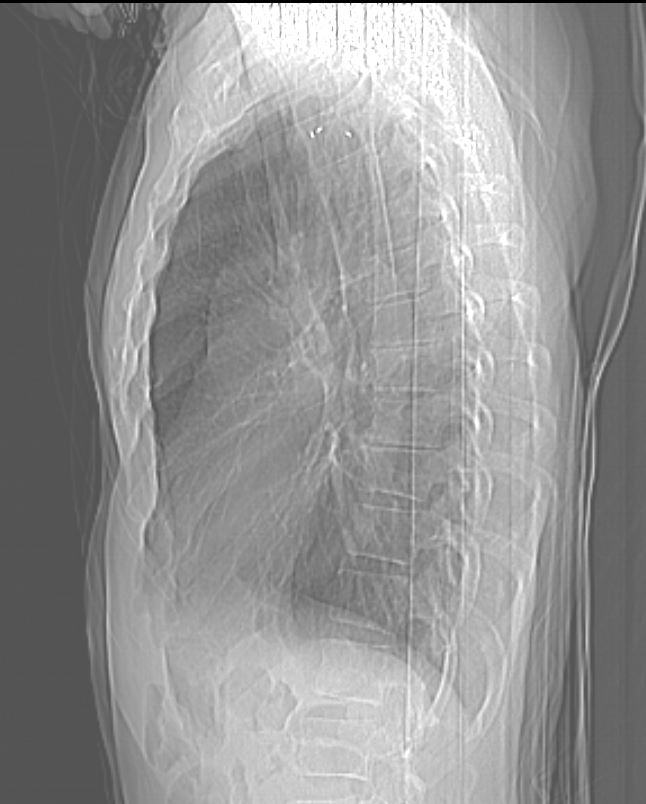
Small Heart on CXR Patient with hyperinflation resulting in compression of the right atrium
Ashley Davidoff MD TheCommonVein.net 63M 002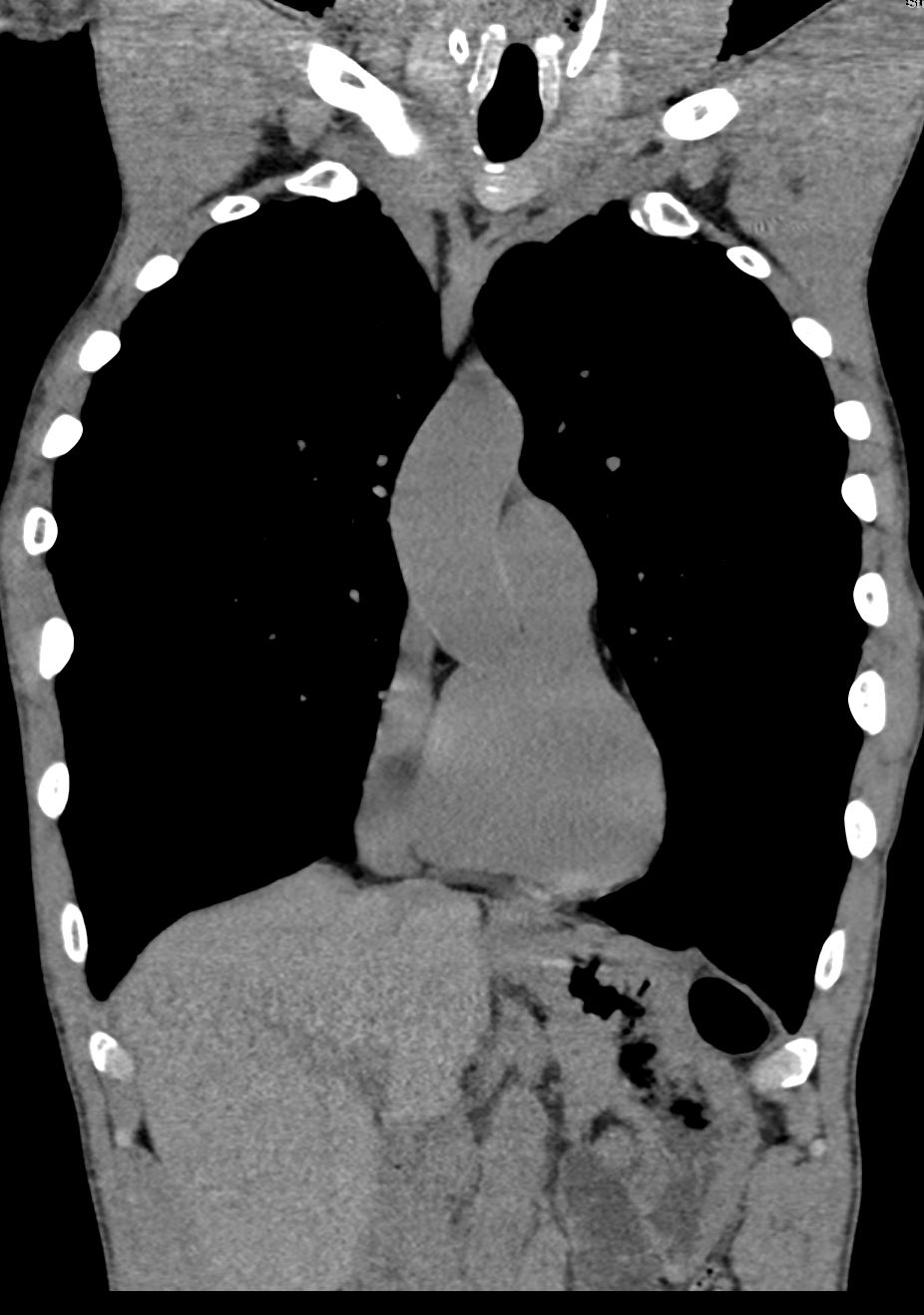
Small Heart on CXR Patient with hyperinflation resulting in compression of the right atrium
Ashley Davidoff MD TheCommonVein.net 63M 003References and Links
- Right Atrium Introduction to Anatomy

